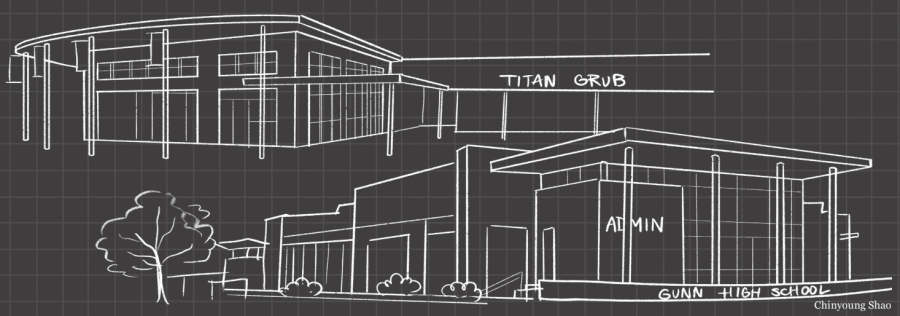Building construction brings new changes to campus
Once put on hold by the COVID-19 pandemic, Palo Alto School District (PAUSD) construction has now resumed at full force, with the district taking advantage of the empty campuses during summer to jumpstart this year’s lengthy list of projects. “It’s the busiest summer we’ve had in a long time,” PAUSD Facilities and Construction Director Eric Holm said. At Gunn, work on a new administration, food services and K building have begun with the creation of temporary administration offices and learning spaces for those displaced by construction.
In 2018, the Measure Z Strong Schools Bond authorized $460 million in funds for PAUSD to modernize or replace classroom facilities. The construction firm Fs3|Hodges has been employed by the district since 2002. Fs3|Hodges Principal Tom Hodges is the program director for the bond program and is involved in the planning and construction of all PAUSD projects.
The first step requires relocating facilities otherwise used during the school year to empty out areas undergoing construction. “We were really inundated with moves this summer,” Holm said. “[Moving] is a logistical challenge. All of the teachers, administration
and support functions pack up in the springtime [and] then the first week of summer, we start moving them.” Prior to beginning construction, PAUSD facilities—and any other state-owned or leased facilities—must receive approval from the Division of State Architects (DSA). For large construction projects, such as the A, B and K building renovation project at Gunn, going through the approval process can significantly delay plans. Changes to building plans can require going through the process again. “We’ve been in the DSA for almost a year now,” Hodges said. “We originally wanted to bid the project last spring and start construction in June but there were just too many complications.”
On top of lengthy DSA approvals, PAUSD Superintendent Don Austin pointed to how global supply chain issues have added to construction lengths due to shortages in building components. “About every budget is going to be over what it’s supposed to be
when it comes to construction,” he said. “More than 20% increases in cost are common right now and that’s in addition to the delays in the projects and supply chain issues. It is the reality we’re dealing with.”
At Gunn, the A, B and K buildings will all undergo major modernization. The first phase of the two-year project will include renovating the food services and administrative buildings to modernize current facilities while creating space for new culinary and design classrooms. The second phase will focus on the K building, converting it into science lab classrooms. “One of the goals of the project was to create more of an identity and a sense of entry onto the campus,” Hodges said. “[We also wanted] to give better visibility to the campus staff of people coming onto the campus.” While waiting for DSA approval over the summer, the district prepared for the A and B building construction by relocating staff and facilities to temporary spaces. The E building was reconfigured to become a temporary administration building while construction occurs. “What we’re doing now is transitioning into construction,” Hodges said. “The main reason why we couldn’t start earlier is that we had to get everybody out of the building and into new facilities. We couldn’t do any of that work while school was happening.”
In order to make space for the temporary administration building, two classrooms had to be relocated to portable classrooms V-5 and V-6. Assistant Principal of Facilities Leonel Argumedo worked alongside staff to relocate them throughout campus. Social studies teacher Arthur Kinyanjui was one of the teachers relocated because of construction. “My colleague and I did not want to move for the sake of our students, and so we had several meetings with the administration team,” Kinyanjui said. “Unfortunately, we were never able to come up with a solution that would let us stay there.” Other facilities, such as all food services, had to be relocated, too. The main service kitchen, used exclusively for food preparation, will now be located in V-18. “For brunch and lunch, [staff] will cart over all the food to P-116 where the distribution will be taking place,” Argumedo said.
The health office will be moved to P-206 and its adjacent rooms. “Initially, when the P building was built, the plan was to move the health office upstairs,” Argumedo said. “It already has what the health office needs in order to run as a health office.” Despite all the relocations, most facilities are slated to return to their initial location in two years’ time. “It was a hard decision [deciding] who we would move,” Argumedo said. “In the end, we have to weigh what was going to be the least disruptive for students and the school as a whole. It is a big sacrifice that those teachers are doing [this, and] we’re thankful that they were flexible. Once the admin building is built, we’ll move back and the E building will go back to what it was.”
During the week before school, heavy machinery was present on campus, tunneling underneath concrete walkways to touch up the sewer system. “They’re also tunneling underneath to add fiber cables,” Argumedo said. “I wasn’t aware that this was going to happen or that it was part of the work.” Another area undergoing construction is the Bow Gym, where a new gender neutral locker room and bathrooms are being built. “There will be eight changing stalls, two of them will be ADA (Americans with Disabilities Act) compliant,” Argumedo said. “We hope that it’ll be completed by September.”
On August 16, the district’s board of education will begin the bidding process for the A, B and K building project to select the most
suitable subcontractor to help execute the build. “Once we get the bids and review them, the board has to approve them at their next meeting, which is [on] August 23,” Hodges said. “Once the board awards that, then it’ll probably take them two weeks to get legal requirements in place before we can issue a notice to proceed.
We don’t really anticipate any work happening until mid-September.” Once the work is approved, the demolition phase of the construction project will begin. Because elements of the original buildings will remain intact, only select areas will be demolished. This aspect of the construction will in turn reduce the amount of noise that would have otherwise been created with a full-scale demolition. “[Selective demolition] is not like a tractor coming out tearing down a building,” Hodges said. “[Construction workers] are [first] going to be inside the building tearing down. The exterior walls would be the last thing to come down. That will be disruptive, but hopefully it’ll just be limited to some short periods of time.” Phasing the project by building the A and B buildings separately from the K building will hopefully reduce the construction’s consequences on student learning. Despite the precautions, the project will still have major effects on Gunn’s students and staff. “It won’t be on both sides of campus at the same time, but [the construction] will be felt,” Holm said. “It’s right in the heart of your campus so it’s definitely going to have a similar feel as the P building [construction]. You kind of have to live through it for the next class—that’s always the hard thing with construction. It’s a never ending cycle.”
Your donation will support the student journalists of Henry M. Gunn High School. Your contribution will allow us to purchase equipment and cover our annual website hosting costs.

On staff since August 2020, Senior Raphael Semeria is a managing editor for The Oracle. When he is not scrambling to contact sources, he can be found at...




